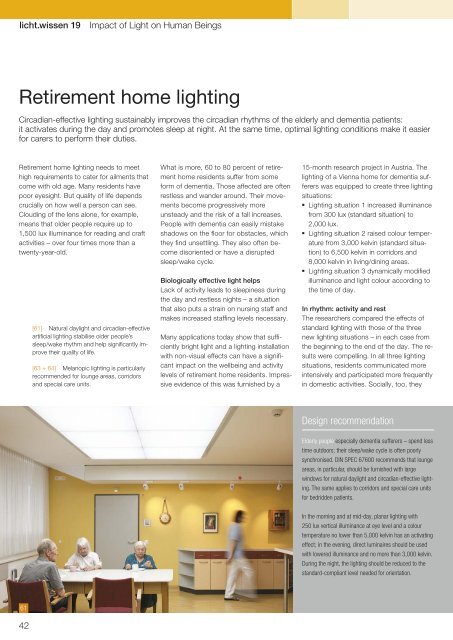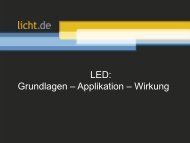licht.wissen 19 No. "Impact of Light on Human Beings"
Light synchronises our “internal clock”. Lighting that copies daylight has more than just a visual impact; it supports bodily functions 24 hours a day. Booklet 19 is intended for all those who want to delve into the topic of Impact of Light on Human Beings. The 56 pages helps to get an overview of what melanopic light can effect. Free Download at www.licht.de/en
Light synchronises our “internal clock”. Lighting that copies daylight has more than just a visual impact; it supports bodily functions 24 hours a day. Booklet 19 is intended for all those who want to delve into the topic of Impact of Light on Human Beings. The 56 pages helps to get an overview of what melanopic light can effect. Free Download at www.licht.de/en
Create successful ePaper yourself
Turn your PDF publications into a flip-book with our unique Google optimized e-Paper software.
<str<strong>on</strong>g>licht</str<strong>on</strong>g>.<str<strong>on</strong>g>wissen</str<strong>on</strong>g> <str<strong>on</strong>g>19</str<strong>on</strong>g><br />
<str<strong>on</strong>g>Impact</str<strong>on</strong>g> <str<strong>on</strong>g>of</str<strong>on</strong>g> <str<strong>on</strong>g>Light</str<strong>on</strong>g> <strong>on</strong> <strong>Human</strong> Beings<br />
Retirement home lighting<br />
Circadian-effective lighting sustainably improves the circadian rhythms <str<strong>on</strong>g>of</str<strong>on</strong>g> the elderly and dementia patients:<br />
it activates during the day and promotes sleep at night. At the same time, optimal lighting c<strong>on</strong>diti<strong>on</strong>s make it easier<br />
for carers to perform their duties.<br />
Retirement home lighting needs to meet<br />
high requirements to cater for ailments that<br />
come with old age. Many residents have<br />
poor eyesight. But quality <str<strong>on</strong>g>of</str<strong>on</strong>g> life depends<br />
crucially <strong>on</strong> how well a pers<strong>on</strong> can see.<br />
Clouding <str<strong>on</strong>g>of</str<strong>on</strong>g> the lens al<strong>on</strong>e, for example,<br />
means that older people require up to<br />
1,500 lux illuminance for reading and craft<br />
activities – over four times more than a<br />
twenty-year-old.<br />
[61] Natural daylight and circadian-effective<br />
artificial lighting stabilise older people’s<br />
sleep/wake rhythm and help significantly improve<br />
their quality <str<strong>on</strong>g>of</str<strong>on</strong>g> life.<br />
[63 + 64] Melanopic lighting is particularly<br />
recommended for lounge areas, corridors<br />
and special care units.<br />
What is more, 60 to 80 percent <str<strong>on</strong>g>of</str<strong>on</strong>g> retirement<br />
home residents suffer from some<br />
form <str<strong>on</strong>g>of</str<strong>on</strong>g> dementia. Those affected are <str<strong>on</strong>g>of</str<strong>on</strong>g>ten<br />
restless and wander around. Their movements<br />
become progressively more<br />
unsteady and the risk <str<strong>on</strong>g>of</str<strong>on</strong>g> a fall increases.<br />
People with dementia can easily mistake<br />
shadows <strong>on</strong> the floor for obstacles, which<br />
they find unsettling. They also <str<strong>on</strong>g>of</str<strong>on</strong>g>ten become<br />
disoriented or have a disrupted<br />
sleep/wake cycle.<br />
Biologically effective light helps<br />
Lack <str<strong>on</strong>g>of</str<strong>on</strong>g> activity leads to sleepiness during<br />
the day and restless nights – a situati<strong>on</strong><br />
that also puts a strain <strong>on</strong> nursing staff and<br />
makes increased staffing levels necessary.<br />
Many applicati<strong>on</strong>s today show that sufficiently<br />
bright light and a lighting installati<strong>on</strong><br />
with n<strong>on</strong>-visual effects can have a significant<br />
impact <strong>on</strong> the wellbeing and activity<br />
levels <str<strong>on</strong>g>of</str<strong>on</strong>g> retirement home residents. Impressive<br />
evidence <str<strong>on</strong>g>of</str<strong>on</strong>g> this was furnished by a<br />
15-m<strong>on</strong>th research project in Austria. The<br />
lighting <str<strong>on</strong>g>of</str<strong>on</strong>g> a Vienna home for dementia sufferers<br />
was equipped to create three lighting<br />
situati<strong>on</strong>s:<br />
<str<strong>on</strong>g>Light</str<strong>on</strong>g>ing situati<strong>on</strong> 1 increased illuminance<br />
from 300 lux (standard situati<strong>on</strong>) to<br />
2,000 lux.<br />
<str<strong>on</strong>g>Light</str<strong>on</strong>g>ing situati<strong>on</strong> 2 raised colour temperature<br />
from 3,000 kelvin (standard situati<strong>on</strong>)<br />
to 6,500 kelvin in corridors and<br />
8,000 kelvin in living/dining areas.<br />
<str<strong>on</strong>g>Light</str<strong>on</strong>g>ing situati<strong>on</strong> 3 dynamically modified<br />
illuminance and light colour according to<br />
the time <str<strong>on</strong>g>of</str<strong>on</strong>g> day.<br />
In rhythm: activity and rest<br />
The researchers compared the effects <str<strong>on</strong>g>of</str<strong>on</strong>g><br />
standard lighting with those <str<strong>on</strong>g>of</str<strong>on</strong>g> the three<br />
new lighting situati<strong>on</strong>s – in each case from<br />
the beginning to the end <str<strong>on</strong>g>of</str<strong>on</strong>g> the day. The results<br />
were compelling. In all three lighting<br />
situati<strong>on</strong>s, residents communicated more<br />
intensively and participated more frequently<br />
in domestic activities. Socially, too, they<br />
Design recommendati<strong>on</strong><br />
Elderly people especially dementia sufferers – spend less<br />
time outdoors; their sleep/wake cycle is <str<strong>on</strong>g>of</str<strong>on</strong>g>ten poorly<br />
synchr<strong>on</strong>ised. DIN SPEC 67600 recommends that lounge<br />
areas, in particular, should be furnished with large<br />
windows for natural daylight and circadian-effective lighting.<br />
The same applies to corridors and special care units<br />
for bedridden patients.<br />
In the morning and at mid-day, planar lighting with<br />
250 lux vertical illuminance at eye level and a colour<br />
temperature no lower than 5,000 kelvin has an activating<br />
effect; in the evening, direct luminaires should be used<br />
with lowered illuminance and no more than 3,000 kelvin.<br />
During the night, the lighting should be reduced to the<br />
standard-compliant level needed for orientati<strong>on</strong>.<br />
61<br />
42

















